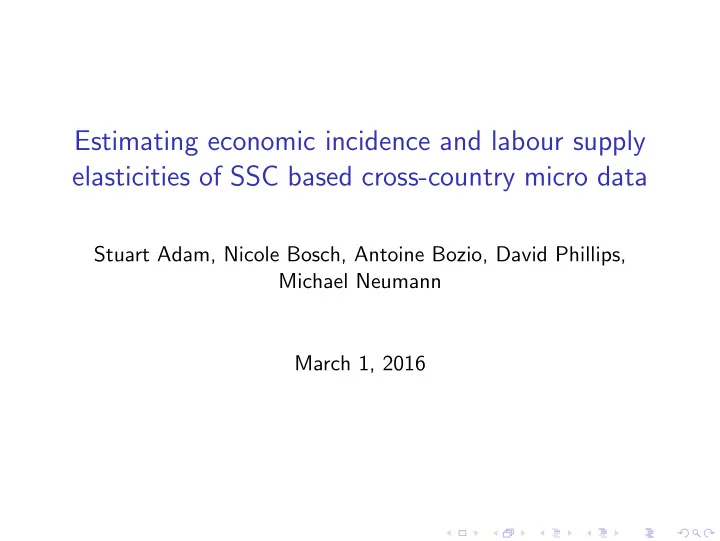

Estimating economic incidence and labour supply elasticities of SSC based cross-country micro data Stuart Adam, Nicole Bosch, Antoine Bozio, David Phillips, Michael Neumann March 1, 2016
Motivation Methodology Outlook Outline Motivation Methodology Outlook
Motivation Methodology Outlook Motivation ◮ Challenges for country-specific micro studies ◮ Natural experiments : rare, availability of control groups, external validity, short-term (legal=economic incidence) ◮ Panel studies : mainly exploit variation over earnings distribution and/or time, exogenous variation? ◮ Individual vs. market-level outcomes ◮ Differences between micro and macro estimates
Motivation Methodology Outlook This study Estimate economic incidence of and behavioural responses to SSC based on administrative cross-country micro data ◮ Identification ◮ Use other countries as control groups (same location in the earnings distribution) ◮ Exploit potentially larger variation across countries without averaging on country-level ◮ Aggregate on different levels to examine differences in individual- and market-level outcomes
Motivation Methodology Outlook Literature Jaentti, Pirttilae and Selin (2015) ◮ Estimation of labour supply elasticities (w.r.t. income taxes) based on cross-country micro-data ◮ Micro, Macro, Micromacro ◮ Data: Repeated cross-sections, Luxembourg Income Study ◮ Tax measures from OECD tax database ◮ No evidence for systematic differences
Motivation Methodology Outlook Our approach ◮ Focus on SSC ◮ Long panel of admin data (1975-2010) ◮ Accurate earnings data but (for most countries) no hours of work ◮ Focus on our 4 countries (FRA, GER, NED, UK) ◮ Thorough calculation of marginal and average SSC rates by micro-simulation ◮ Challenge: Comparable data/measures across time and countries
Motivation Methodology Outlook Aggregation Aggregate data to cells defined by quantiles of the earnings distribution ◮ Data security prevents merging individual admin data across countries ◮ From almost individual to country-level : More spillovers but less precision ◮ Variation : Same quantiles of earnings distribution in different countries
Motivation Methodology Outlook Specification Empirical specification mainly follows Lehmann, Marical and Rioux (2013) ∆ j ln ( z qct ) = α + β essc ∆ j ln (1 − τ essc qct ) + β essc ∆ j ln (1 − t essc qct )+ t τ + β rssc ∆ j ln (1 − τ rssc qct ) + β rssc ∆ j ln (1 − t rssc qct )+ t τ + β inc τ ∆ j ln (1 − τ inc qct ) + β inc ∆ j ln (1 − t inc qct ) + ǫ qct t q : quantile , c : country, t : year essc : employee SSC, rssc : employer SSC, inc : income tax ∆ j : change between t and t − j for j = (1; 3) τ : empirical marginal SSC rate: substitution effect t : empirical average SSC rate: incidence and income effect
Motivation Methodology Outlook Instruments ◮ τ , t are functions of z : Need to be instrumented ◮ Gruber and Saez (2002) ◮ SSC rate in t based on earnings in t − j ◮ f ( z t − j ) controls for differential income trends and mean reversion ◮ Kopczuk (2005) : two separate controls for mean reversion and differential income trends ◮ SSC rate in t based on z t − j ◮ Controls: f ( z t − j − 1 ) and f ( z t − j − z t − j − 1 ) ◮ Weber (2014) : instruments don’t satisfy exogeneity requirement ◮ SSC rate in t based on z t − j − k (we use k ∈ { 1 , 2 } ) ◮ Control for f ( z t − j )
Motivation Methodology Outlook Instruments and cells Additional endogeneity issue: Cells are defined by outcome variable Two approaches 1. Make use of individual panel ◮ First calculate individual changes in labour costs and (predicted) tax rates ◮ Then average within cells based on z t − j ◮ Mean reversion: Same as for instrument
Motivation Methodology Outlook Instruments and cells II 2. Pseudo-panel ◮ First average labour costs and (predicted) tax rates within cells based on z t ◮ Then calculate changes ◮ Mean reversion averaged out ◮ Selection into cells due to tax changes
Motivation Methodology Outlook Outlook ◮ Output and merge data ◮ Estimation
Motivation Methodology Outlook References Gruber, Jon and Emmanuel Saez , “The elasticity of taxable income: evidence and implications,” Journal of Public Economics , April 2002, 84 (1), 1–32. Jaentti, Markus, Jukka Pirttilae, and Hakan Selin , “Estimating labour supply elasticities based on cross-country micro data: A bridge between micro and macro estimates?,” Journal of Public Economics , 2015, 127 , 87 – 99. The Nordic Model. Kopczuk, Wojciech , “Tax bases, tax rates and the elasticity of reported income,” Journal of Public Economics , 2005, 89 (1112), 2093 – 2119. Lehmann, Etienne, Franois Marical, and Laurence Rioux , “Labor income responds differently to income-tax and payroll-tax reforms,” Journal of Public Economics , 2013, 99 (C), 66–84.
Motivation Methodology Outlook Weber, Caroline E. , “Toward obtaining a consistent estimate of the elasticity of taxable income using difference-in-differences,” Journal of Public Economics , 2014, 117 , 90 – 103.
Recommend
More recommend